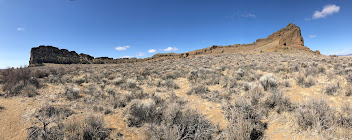Wandering in the Rain Shadow
Larch Trees
Autumn in
Oregon is a visual feast. Maples, oaks
and cottonwoods serve up a rich bounty of vibrant colors each year. Most of us
learned as kids that these and other broad-leaved trees are deciduous—that is,
they lose their leaves every fall—while conifers, the needle-leaved, cone-bearing
trees, remain evergreen throughout the year. This is generally true—with one
glorious exception in Oregon: the
western larch. One of nature’s great
paradoxes, the western larch is a conifer that loses its needles every fall.
Before they drop, larch needles turn electric yellow and then drift to the
ground to lie in a golden skirt at the base of each bare tree. A bright November morning finds me on a quest
for turning larch trees in the Metolius Preserve in central Oregon, only eight
miles east of the Cascade Crest.
I have the
forest all to myself as I start my hike around the Larch Trail loop. This is a
companion to the Fir and Pine Trails in the Metolius Preserve, which is owned
and maintained by the Deschutes Land Trust, a non-profit agency dedicated to
conserving natural areas in central Oregon. Visitors are welcome year-round.
The sweet spice of ponderosa pine floats on the air as I enter the park-like forest. Ponderosa is the dominant tree in the forests east of the Cascades. The trees’ burnt-orange trunks have thick, flaky bark; their pear-sized, prickly cones decorate the forest floor. Deeper into the forest, low-angled autumn sunlight highlights a multicolored larch tree. The needles on some of its branches are still green, while others have turned a luminous gold and seem to glow from within.
Larch needles grow in tufts on the ends of small woody knobs that line each feathery branch. Unlike those of pine and fir, larch needles are soft and delicately slender. During the budburst of spring, their iridescent chartreuse contrasts with the deeper green of neighboring conifers. When fall arrives, the golden needles shine like beacons in the somber forest.
The trail leads me across a sturdy footbridge over the North Fork of Lake Creek. The water runs clear and cold and I search the shallow riffles for signs of migrating fish. No luck. Hiking on, I enter a stand of older larch trees that tower above me. The lowest branches on mature larches are often 50 to 75 feet above the ground. These trees are easily 150 feet tall. Their ramrod-straight trunks rise like the shafts of enormous arrows pointing skyward.
As I hike on
in solitude through a series of open areas in the forest, the stillness is suddenly
broken by a swoop of motion to my left. An enormous Great Gray Owl lifts off
from a snag and crosses above the path in front of me with a couple of deep,
slow wingbeats. It is a rare event to witness this elusive creature. I’ve only
seen a Great Gray Owl once before, and that was with the benefit of several
tips from seasoned birders. To stumble upon this one is a true gift.
The Great Gray Owl is the largest owl in Oregon. This individual stands at least two and a half feet tall and has a five-foot wingspan. Its head seems as big as a volleyball; its large facial discs are marked with dark concentric rings that spread out from fierce yellow eyes. The owl’s cryptic color pattern of gray and brown feathers allows it to vanish among the trees like a ghost melting through a wall. It disappears from my view as suddenly as it appeared. Known to favor open forest habitats and to hunt in the daytime, the Great Gray Owl is a magnificent predator. The voles and pocket gophers living here caught a lucky break when I walked by and disturbed the owl’s quest for prey.
Delighted
with my good fortune, I finish the Larch Trail loop. As I drive back over Santiam
Pass and return to the more familiar Douglas-fir forest on the wetter west
side, I’m grateful for the diversity of our native forests. Oregonians are
truly blessed.






.jpg)




.jpg)
.jpg)







.jpg)

.jpg)

.jpg)
.jpg)















